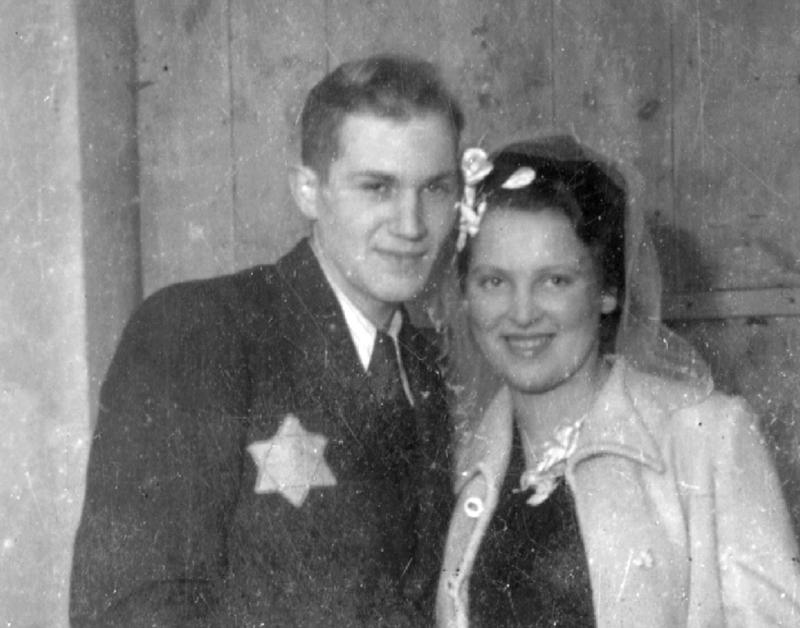|
Getting your Trinity Audio player ready...
|
“Weddings During the Holocaust”: A New Exhibit by Yad Vashem
Edited by: Fern Sidman
In an extraordinary effort to shed light on a lesser-known aspect of Holocaust history, Yad Vashem, the World Holocaust Remembrance Center in Jerusalem has launched an online exhibit titled “Weddings During the Holocaust,” according to a report that appeared on Friday in The New York Times. This is one of 70 ongoing online exhibitions curated by Yad Vashem, Israel’s foremost Holocaust memorial and museum. The NYT report added that the exhibit, which debuted on February 14, 2024, stands out as the only retrospective focused on couples who married during World War II—a period when millions of Jews were systematically exterminated by the German Nazis and their allies.
The project was spearheaded by Natalie Mandelbaum, who has been with Yad Vashem since 2014 and took on the role of online exhibitions coordinator in the museum division last August. According to the information provided in the NYT report, this photographic project, her first in this new role, was six months in the making and involved a collaborative effort from researchers, digital image organizers, and graphic designers.
“We wanted to ask the question: ‘What made people get married in those horrible years,’” said Mandelbaum during a Zoom interview with the NYT from her home in Jerusalem. “The men and women who got married during the Holocaust were so brave and had such a complicated life — not a lot of people know these stories. The goal was to make them accessible to the world.”
“Weddings During the Holocaust” features 11 couples and over 40 photographs, offering a poignant exploration of their weddings amidst the backdrop of war, persecution, and survival, the NYT report noted. The exhibit is structured around three distinct periods:
Weddings Under Restrictive Law: This section depicts the initial days of the occupation and deportations when Jews were still in their homes. It highlights how couples managed to marry despite the increasingly oppressive laws and restrictions imposed upon them.
Weddings in Ghettos and Camps: This section showcases Jews who found love and chose to marry in the ghettos and concentration camps. These stories emphasize the resilience and hope of individuals who sought to affirm their humanity and love even in the direst circumstances.
Weddings After Liberation: This final section captures the determination of Jews to rebuild their lives and families after the Holocaust. These post-liberation weddings symbolize a commitment to life and continuity despite the immense loss and trauma experienced during the war.
The exhibit’s photos and stories provide a deeply personal look at the lives of Jewish couples during the Holocaust. The NYT report indicated that they reveal moments of joy, resilience, and hope amid unimaginable suffering and loss. Each photograph is accompanied by narratives that delve into the couples’ backgrounds, their love stories, and the challenges they faced.
By highlighting these weddings, Yad Vashem aims to honor the courage and spirit of those who chose to celebrate love and union in the face of horror. The exhibit not only commemorates their bravery but also serves as a powerful reminder of the human capacity for hope and resilience.
The decision to launch the exhibit online was driven by a desire to make these stories accessible to a global audience. “The goal was to make them accessible to the world,” Mandelbaum emphasized during the interview with the NYT. The online format allows people from all over the world to engage with these poignant stories and reflect on the broader history of the Holocaust.
After the horrors of the Holocaust, many survivors found themselves in displaced persons camps scattered across Europe. These camps became temporary homes for those who had lost everything — their families, homes, and communities.
“After the war, many Holocaust survivors found themselves in displaced persons camps in Europe. Many focused their efforts on emigrating from there to build new lives in other countries,” Mandelbaum explained to the NYT. “It is important to understand that many did not have a home or community to return to. Some migrated to Mandatory Palestine, later the state of Israel, while others immigrated to the United States and other Western countries. There were also Holocaust survivors who remained in Eastern Europe.”
This mass migration was a testament to the survivors’ resilience and their determination to forge new paths despite the overwhelming loss and trauma they had endured.
“Even amid the Holocaust’s horrors, individuals chose love and marriage, defying all odds,” Mandelbaum told the NYT. This defiance was not just about personal happiness but about the broader human drive to affirm life and continuity even when surrounded by death and destruction.
The exhibit goes beyond photographs, offering a rich array of artifacts that bring these stories to life. Wedding invitations, diary entries, birth announcements, signed ketubahs (Jewish marriage contracts), and personal objects are paired with descriptions and information about each couple, as per the information provided in the NYT report. These items provide a deeper understanding of the personal and cultural significance of these weddings.
“Getting married wasn’t just about love — it was bigger than that, it was beyond love,” Mandelbaum reflected when speaking with the NYT. “These survivors lived with the dead constantly in their thoughts, yet they rose again and created a new world together. They wanted the continuation, to build a home after homes were destroyed and their family was murdered. These survivors wanted something for themselves; they wanted a place in the world. And they wanted love.”
The 11 couples highlighted in the exhibit each have unique stories that reflect the broader experiences of Jews during the Holocaust. As was reported by the NYT, their weddings, whether conducted in secret under oppressive laws, in the harsh conditions of ghettos and concentration camps, or in the hopeful days following liberation, symbolize more than personal union; they represent a collective assertion of humanity and hope.
For example, one couple might have married clandestinely in a ghetto, with the ceremony witnessed only by a few close friends and relatives. Another might have found solace in each other’s company in a concentration camp, deciding to marry as an act of resistance and affirmation of life, according to the information contained in the NYT report. A third couple might have met in a displaced persons camp, their wedding marking the beginning of a new chapter as they prepared to emigrate and rebuild their lives in a new country.
The exhibit aims to make these powerful stories accessible to a global audience, emphasizing the importance of remembering and understanding the full scope of human experience during the Holocaust. By highlighting these intimate, personal moments of joy and love, Yad Vashem challenges viewers to see the Holocaust not only as a story of immense suffering but also as a story of human resilience and the indomitable spirit of those who survived.
“Weddings During the Holocaust” is more than just an exhibit; it is a tribute to the strength of the human spirit in the face of unimaginable adversity. Through photographs, artifacts, and personal narratives, Yad Vashem provides a unique and deeply moving insight into the lives of those who chose love amidst the ruins. This exhibit serves as a reminder of the enduring power of love and the profound resilience of the human spirit, ensuring that these stories of bravery and hope are preserved for future generations.





Where can I send a photo of a wedding in Munich after the Holocaust?